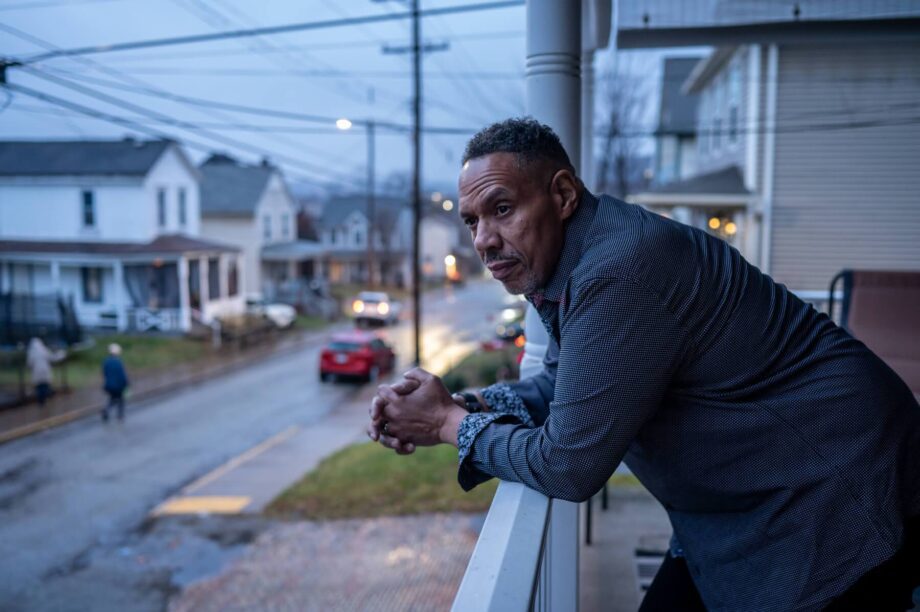Alan Scott’s loved ones described the triumphs and tragedies in his life.
He earned a “top salesman of the year” award from his employer, one of the largest pet food companies in the country at the time. He was also a sharp dresser who donned tailored suits and hats for outings with his friends.
He lived with prostate cancer for a decade, enduring chemotherapy and other treatments that couldn’t keep the cancer from spreading to his bones. And he sought solace during hard times at a church near Braddock, where he grew up during the 1950s, ’60s and ’70s — a period that led to the shuttering of most steel mills across the Monongahela Valley.


(From left) Alan Scott in Chicago in 1987. Alan and Elaine Scott on their wedding day, July 14, 1984, in Alsip, Illinois. Alan Scott in Downtown Pittsburgh in 2017. (Courtesy photos)
Scott died in July at age 70. It wasn’t the cancer that took him. Rather, it was a fatal combination of fentanyl and cocaine, according to the Allegheny County Office of the Medical Examiner. He’s survived by his wife, daughter, two sisters and other family members and friends, some of whom described their grief during interviews with PublicSource.
“I really thought that we were just gonna lose him eventually, but we were gonna lose him to the cancer,” said Scott’s wife, Elaine, who asked to be identified by her middle name. “Not like what happened.”
Scott’s death is representative of one of the county’s starkest health disparities: Black men born between 1951 and 1970 have died of overdose more than any other group of people here. In the Pittsburgh area, only Black men born between 1971 and 1990 are dying from overdoses at a rate nearly as high. The two groups are dying at high rates in the county while overdose deaths in the U.S. — fueled by opioids such as fentanyl — are plummeting overall, according to the Centers for Disease Control and Prevention.
The overdose crisis for Black men in American cities began decades ago — along with economic dislocation and abundance of heroin. In recent years, overdoses spiked among new populations — younger, whiter and more rural. But as that massive tide of deaths appears to be ebbing overall, death rates still remain unusually high among the population that has long suffered the most, in cities including Baltimore, Washington, D.C., San Francisco, Philadelphia, Chicago and the Pittsburgh area.
About the data
The Baltimore Banner, the New York Times and Stanford University’s Big Local News analyzed CDC Wonder mortality data for 56 counties with 40 or more deaths of this generation. The big takeaway: The OD crisis is killing Black men born between 1951 and 1970 more than it’s hitting any other demographic cohort. Here are key findings regarding fatal overdoses in Allegheny County:
- The number of Black men from this generation who live in Allegheny County is small compared to counties where this cohort effect is the strongest, but it has more severe disparities than most of the 56 counties where the cohort effect was identified.
- Black men from this generation make up about 1% of the county population, but account for 6.7% of all overdoses deaths. Between 2018 and 2022, they died of overdose at rates 11.4 times the national average, the 18th highest rate for that cohort of the 56 counties.
- In Allegheny County, Black men of this generation have died of overdose at rates 11.4 times higher than the national overdose rate and 5.3 times the county’s overdose death rate.
Experts and county officials pointed to a number of causes behind the high death rate among older Black men, including:
Structural racism underpins most of these factors, they said.
This is “a generation that had really been constructed [by policymakers] as the criminal drug user during the 1980s,” said Katherine McLean, associate professor of administration of justice at Penn State Greater Allegheny in McKeesport. “It’s not hard to follow how this group — who have had such negative experiences with drug policy institutions, with the criminal justice system — would be disproportionately at risk now.”
Experts and officials were less sure about why younger Black men here are dying of overdose nearly as often as the older group. Of the 56 counties included in the analysis, fewer than half showed similar death rates between the older and younger groups.
The county has rolled out a number of initiatives to narrow the disparities, including a program launched this year called Connect Protect Recover, aimed at supporting loved ones and caregivers of Black people with substance use disorders.
What county officials know
County human services officials told PublicSource they’re aware of the high overdose death rate among older Black men and described its potential causes.
Erin Dalton, director of the Allegheny County Department of Human Services, said there has been a rise in polysubstance use deaths, which involve two or more drugs intentionally or unintentionally taken together, among older Black men between pre-pandemic and post-pandemic years. These deaths were likely fueled by an unpredictable drug supply that’s contaminated by illicit fentanyl and other adulterants, added Stuart Fisk, a nurse practitioner and manager for coordination of opioid settlement funds at the department’s Office of Behavioral Health.
Scott died of “multiple drug intoxication of fentanyl and cocaine,” according to the county medical examiner’s death investigation. It’s unclear if he knew he was taking more than one substance, though his wife said he was found with fentanyl test strips nearby.
“Polysubstance use [has] always pushed people … into a situation where they’re likely to die,” said Fisk.
He added that older Black men who use drugs bear “a higher chronic disease burden,” possibly compounded by complications from COVID-19 infections, which puts them at risk for overdose. In addition to cancer, Scott suffered from seizures and had a heart attack at a young age.
Black people make up 65% of the Allegheny County Jail’s population, but just 12% of the county’s population overall — a phenomenon seen nationally and, according to experts, a reflection of racism in the criminal justice system. Yet white people in the jail are accessing medications for opioid use disorder [MOUD] at a higher rate than Black people, which Fisk said is likely reflective of disparities in access to treatment in the community. Until recently, the jail only continued medication for those who had a valid prescription when they were booked. It expanded access by inducting people on buprenorphine starting in December 2023, and on methadone starting last month.
The relatively high overdose rate among the county’s younger Black men “might actually be much more widespread than we think,” said Raagini Jawa, an addiction medicine doctor and assistant professor of medicine at the University of Pittsburgh. She pointed to research predicting a significant increase in overdose deaths nationally among Black men in their 30s and 40s through 2025, and called for more research to understand why.
Born into deindustrialization
The highest levels of overdose fatalities are clustered in distressed parts of the City of Pittsburgh and deindustrialized towns along the Monongahela River, according to geographic data from OverdoseFreePA.
Scott was born in the Mon Valley town of Braddock, home to the Edgar Thomson Steel Works, one of the few steel mills still operating. His father was a mechanic and his mother was a nurse. They raised him and his sisters in a once-flourishing borough that was on the verge of steep decline. The steel industry collapsed as he was coming of age in the 1970s, leading to the loss of thousands of jobs and an exodus of white residents, leaving behind Black families trapped by redlining. Most Braddock residents today are Black and many are aging, according to census data.
McLean’s research shows how deindustrialization — which hit Black households the hardest — creates a “risk environment” for overdose. Her interviews with people who use drugs in McKeesport, a deindustrialized city near Braddock, revealed that hopelessness, social isolation and lack of opportunity were driving their heroin use. Her findings confirm what local advocates have known for years.

“It’s not hard to find these stories across most Black families in the area,” said Isaac Bunn, 55, the descendant of Black steelworkers and founder of the Braddock Inclusion Project, a nonprofit focused on alleviating poverty. “I’ve actually seen it,” he said, describing how his close friend died of overdose in 2017.
Scott began using marijuana when he was a teenager. He had turned to more dangerous drugs, such as cocaine, by the time he married Elaine in 1984 and started a life with her in her native Chicago. His substance use disorder forced the couple to live separately, though they stayed in close contact.
Scott’s drug use derailed his sales career, causing a devastating job loss and periods of unemployment. He sought treatment, most recently around 2017, but always relapsed after periods of abstinence. He returned to Braddock in 2010, but hoped to eventually rejoin Elaine in Chicago. They discussed the possibility shortly before he died of overdose in Braddock Hills on July 28.
“Alan was a person who had goals and dreams, and he was definitely a wonderful man,” said Elaine, 72, a retired elementary school principal. “And when he loved, he loved hard.”
The long shadow of the drug war
Black people and white people have historically used drugs at similar rates, but policymakers have treated the two groups differently over decades.
When the crack cocaine epidemic during the 1980s was hitting Black communities especially hard, Congress responded by setting mandatory minimum sentences for drug offenses, which further fueled the mass incarceration of Black people. Experts said the response was markedly different when a surge in opioid prescriptions in the late 1990s led to overdose deaths in white areas. In 2017, President Donald Trump declared a public health emergency and announced efforts to expand access to treatment and recovery services.
“They’re fearful that they’ll be arrested on a probation violation or an outstanding warrant or, God forbid, assault or homicide, if it was determined that they provided the drugs that led to the overdose.”
“Think about a pendulum” that swings between punishment and treatment based on how society frames people who use drugs, said Alex Bennett, research associate professor and director of the opioid overdose prevention program at New York University’s School of Global Public Health. He lived in Pittsburgh from 1997 to 2009 and said white people were “the face of the opioid overdose epidemic” in local news coverage at the time.
The shift in policy during the opioid crisis led to the introduction of good samaritan laws in Pennsylvania and other states, which offer legal protection to those who call emergency services to report an overdose. But research shows that fear of being criminalized could still keep people from calling 911 — especially if an overdose takes place in a highly policed Black neighborhood.
“They’re fearful that they’ll be arrested on a probation violation or an outstanding warrant or, God forbid, assault or homicide, if it was determined that they provided the drugs that led to the overdose,” said McLean.
A police officer told Scott’s wife that he died shortly after 9 a.m. at a residence where others were staying. His death wasn’t reported to emergency services until around 3 p.m. that day.
How officials are responding to disparities
McLean and her colleague, Sandra Trappen, proposed a program to McKeesport officials that would divert police away from overdose-related 911 calls.
Instead of police, the “rapid response” program would send a team composed of a social worker, emergency medical services worker and counselor or certified peer specialist with lived addiction experience. They pitched it during a 2021 meeting with McKeesport Mayor Michael Cherepko, the police chief at the time and other officials. Trappen even applied for a grant to launch a pilot of the program.
“And of course they just ghosted me,” said Trappen, an assistant professor of criminal justice at Penn State Greater Allegheny, describing her unanswered follow-ups after the meeting. “And I had put a year of effort into it at that point, and I had to cut my losses,” she added, explaining that similar models have been successful elsewhere, and the program could have had “tremendous social benefits” for the people of McKeesport.
A spokesperson for Cherepko wrote in an email that “our talks seemed to dissolve” when his office tried to link the professors with Allegheny County Emergency Services and then-County Executive Rich Fitzgerald’s office. The mayor is open to continuing talks with the professors, but “a complete change in response procedure is not something McKeesport can authorize,” she added. “Social workers would be valued members of a complete response team.”
Since 2008, 241 people — 66 of whom were Black — have died of overdose in McKeesport, where Black people died of overdoses at a slightly lower rate than white people. Penn Hills is the only suburban municipality with a higher number of overdose deaths, according to a county dashboard.
County human services officials described the programs and initiatives they’ve introduced to address racial disparities in overdose deaths.

Connect Protect Recover aims to support loved ones and caregivers because they’re best equipped to help Black people who are battling substance use disorders, and because they’re also suffering. Other measures include a “contingency management” pilot program, backed by brain science and launched last year, that pays people to receive treatment and services.
Dalton and Fisk expect the jail’s newly expanded medication-assisted treatment program to go a long way toward eliminating disparities. People historically deprived of MOUD in the jail faced a high risk of death upon release. Many overdosed when they were on the outside, due to their decreased tolerance for opioids.
“We don’t want people to go to jail,” Dalton said, “but when people do … they can start that care inside the jail and be connected to peers and support and community.” The program could significantly impact the younger Black men who make up a large portion of the jail’s population, she added.
Earlier this year, PublicSource reported on logistical problems affecting the jail’s distribution of MOUD and after-release connections to care. A jail spokesperson wrote in an email last month that improvements have since been made to the program.
The county Health Department is also working to reach Black people in Braddock, McKeesport and other hard-hit areas, wrote Otis Pitts, the department’s deputy director of food, housing and public policy.
It distributes naloxone, the opioid overdose reversal drug, to those who request it via this form. It does community outreach and overdose prevention education, including at senior living centers to engage older Black adults. And it set up naloxone vending machines this year in the most affected communities, though the one in McKeesport became the subject of a zoning dispute and was removed from outside a treatment center in August.

These efforts are important because access to naloxone has historically been unequal across neighborhoods, said Alice Bell, director of the overdose prevention project at Prevention Point Pittsburgh, which provides syringe services in the city’s overdose hotspots. Now available over the counter as a nasal spray, the drug’s previous prescription requirement and other regulations created naloxone deserts, often in places where access was most needed.
When Prevention Point could only distribute naloxone in Oakland during the 2000s, about 90% of the recipients were white. As regulations loosened over the years, the group sought to expand distribution to Black clients by opening locations in the Hill District, Perry Hilltop, Homewood and East Liberty. The share of Black naloxone recipients climbed to 35% over the past few years, while 60% of recipients were white.
“We definitely have done our part to shift the access to naloxone in Black communities,” Bell said.
‘He was there for me’
When Paul Turner, 62, left rehab in 2017, he was greeted outside by his friend, Alan Scott, who took him shopping for essentials and dropped him home in North Braddock. The two had met a few years earlier while both were using crack cocaine, though they only became close friends when they began supporting each other through recovery.
“He was there for me,” Turner said. “That was what brought us together.”
Both men had at one time worked in auto sales, and both men liked to dress well. They also bonded over a shared sense of humor.
“We had jokes that nobody else would understand,” Turner said. “We could look at somebody and just start looking at one another and just start busting out and laughing. He was really just a positive guy. He was loving, he was caring.”

Scott was the first among their small friend circle to enter rehab, and he inspired Turner to begin his own recovery journey in 2017, following a cocaine addiction “that took my late 20s … my 30s, 40s and half my 50s.”
“I was impressed,” he said of Scott’s effort at recovery. “And, also because, if he can do it, I can do it.”
Turner grew up in 1960s Homewood, back when the neighborhood had a strong middle class, stable housing stock and a bustling business district.
At 18, he enrolled at Howard University, then transferred to Duquesne University. He left his degree behind to take a full-time sales job, which led ultimately to director-level appointments at car dealerships and hotels around Pittsburgh and Ohio.
Later, he would come back to Homewood and pick up cocaine. By then, his home neighborhood had been ravaged by disinvestment and segregationist policies employed by surrounding municipalities amid the region’s economic downturn in the 1980s and 1990s. The community was also harmed by aggressive policing, according to De’netta Benjamin-Miller, who runs Sojourner House, a grassroots recovery service based in Homewood.
“I grew up on Larimer Avenue. I saw a community that was vibrant, and I also saw a community that fell to pieces when crack cocaine hit the scene,” Benjamin-Miller said.
“We could look at somebody and just start looking at one another and just start busting out and laughing. He was really just a positive guy. He was loving, he was caring.”
“The city could have done a wonderful job in the ’80s and ’90s and saved some of these families early on. But like I said, it was criminalized, so they did not.”
Turner has remained abstinent since leaving rehab, and has since married and begun a new career as a peer support specialist. Group trips he takes with recovering peers to lunch and the bowling alley give him a deep satisfaction he could never regain in the cutthroat sales world.
Though content in his new field, Turner said a retail theft charge from nearly two decades ago has essentially foreclosed a return to the high-paying sales director positions he once held.

The permanent stain on his record despite the usual leniency shown toward first-time shoplifting charges is just one example of the systemic bias he’s felt oppressed by as a Black American. Another example is today’s more compassionate attitudes toward those suffering from the opioid crisis compared to the hostility of the War on Drugs era.
“Because more whites are in it, they have this softer stance,” Turner said. During the crack epidemic, he said, society’s response was: “Put them in jail. Users, sellers, everybody going to jail, right? They’re all criminals. They’re bums, they’re gonna die. And then when [opioids] became really [prevalent] in the white community, it’s like, ‘Oh, poor things. They need help.’”
Now that Black men are the most at risk in the current epidemic, what’s it going to take to bring meaningful restoration and healing?
“You didn’t care in the beginning,” he said, referring to policymakers and politicians under previous administrations. Until you do care, “it’s not going to change.”
Venuri Siriwardane is PublicSource’s health and mental health reporter. She can be reached at [email protected] or on Bluesky @venuri.bsky.social.
Jamie Wiggan is deputy editor at PublicSource. He can be reached at [email protected].
This story was fact-checked by Abigail Nemec-Merwede.
This reporting has been made possible through the Staunton Farm Mental Health Reporting Fellowship and the Jewish Healthcare Foundation.




